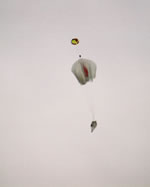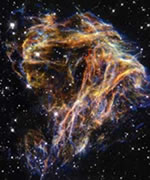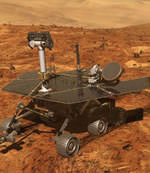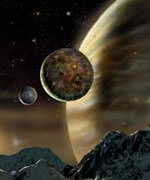
Image credit: Armadillo Aerospace
Texas-based Armadillo Aerospace successfully performed a helicopter drop test on a component of their spacecraft on Sunday. Armadillo is just one of the teams competing for the X-Prize, which will pay $10 million to the first private space ship capable of lifting three people to an altitude of 100km. The company is led by John Carmack, who’s better known as the founder of id software – creators of the popular video games Doom and Quake.
We finished up all of the prep work for the vehicle on Tuesday. We welded in strapping points to hold 600 pounds of ?passenger? sandbags in the cabin area, and we mounted five 45 pound Olympic barbell plates on a peg at the end to simulate the weight of the final engines, plumbing, and backup recovery system that will be on the full size vehicle. We mounted four 2? throat engine shells as placeholders. Total weight is just under 2400 pounds. We use a combination of multiple chain hoists, a palette jack, and a forklift to move the full vehicle around and get it up on the trailer, but we did wind up breaking one of the castor wheels that we had mounted on our tank cradle. If we wind up having to use the 1600 gallon propellant tank (the current one is 850 gallons), we aren?t going to be able to stand the vehicle up under the main girder inside our shop, which will be inconvenient.
On Saturday, we headed out to our test site for the drop test. There were quite a few stares on the road in transit? We had a few spatters of rain, and the wind occasionally gusted to 12 knots, but we were able to perform the drop in relatively calm 6 knot winds.
Anna rented a big RV for the day, which was very worthwhile. It was nice to be able to take a break in an air-conditioned space.
5 State Helicopters arrived with a big Sikorsky for the lifting. It was very convenient that they were based close by, and didn?t have a problem with our unusual application (although they did have us contact the local mayor and sheriff for explicit permission). We were very impressed with the precision that they were able to do the lifting ? we were afraid that the vehicle might get dragged or bounced on the crush cone, which could buckle it before the test even started, but they were able to perfectly pivot it up on the nose, and gently lift it off the ground. If we had known they were that precise, we probably could have skipped renting the forklift truck for recovery and just had them lower the rocket back onto the trailer after the test.
We made several 18? diameter test parachutes that were weighted to drift at about the same rate that the full size parachute was expected to fall. We did the test drop from 1500? AGL, under the assumption that the big vehicle would fall several hundred feet before the main chute was fully deployed. The landing point for the test parachute was satisfactory, so we planned the full vehicle drop for 2000? AGL. Neil rode in the helicopter to do the parachute releasing, and Anna hung out the side of the helicopter (with a safety strap) to get aerial footage.
We had to abort our first attempt to drop the vehicle, because the line that we ran from the helicopter to the Sea-Catch toggle release above the rocket had wrapped itself around the chain so many times that Neil couldn?t pull it hard enough to trigger the release. This was fixed by tying loose loops of plastic every few feet along the chain, which kept the pull-line in place.
On the second try, the release worked perfectly. You can clearly see the naturally unstable aerodynamics of the vehicle, as it starts to tip over almost immediately after release. We all held our breath as it started to fall, but the drogue immediately inflated and started pulling the main canopy out. It was nine seconds from release to full canopy inflation. The opening shock was negligible, barely hitting 2G?s. For high altitude flights, we are aiming for a 200 mph terminal velocity under the stabilizer drogue at the time of main canopy deployment, so opening shock will be much greater then.
The wake of the main canopy is so great that the deployment drogue just rests on the canopy during descent, without any inflation at all. The real deployment system will have a much longer line on the drogue (because it is used for vehicle stabilization before deploying the main), which will probably cause it to trail behind the main chute, still inflated.
The drift was going about where we expected, but we were a little concerned when we saw that the vehicle was oscillating +/- 13 degrees under the canopy, which is a pretty big swing at that length. The actual landing point was unfortunately just behind some low foliage, so we didn?t get a perfect shot of it, but we did see it hit at enough of an angle that it rolled almost back upright as it landed.
We ran over to collapse the chute and examine the state of the vehicle. The crush cone had buckled right at the mounting point from the angled impact, but the vehicle looked basically sound. None of the sandbags in the cabin had broken open. Two of the engine support studs were bent from when it tipped back up.
We had the helicopter pick it back up and drop it off by the trailer, which was a lot more convenient than driving the lift truck over to the vehicle.
When we got it back to the shop, we pulled some things apart to take a closer look. The bent mounting studs unscrewed right out of their mounts, so replacing those is trivial. We are considering adding some more bracing below the engine plates, which would probably keep them from bending at all. When we got the crush cone off, we did find that the cabin had been bent right at the end of the cone, and the buckle in the crush cone had pushed in far enough to crease the honeycomb bulkhead.
We are probably going to continue using this cabin for the first couple flights of the big vehicle, but start on a second-generation cabin structure that will incorporate some improvements for off-angle landings, as well as several other lessons we have learned in working with the current cabin. Because we bonded a mounting flange to the tank, we should be able to simply swap the cabin when we want to.
The accelerometer data showed 10G acceleration peaks during the landing and bounce, which is over twice what we saw with the straight down drop tests that collapsed perfectly. This is still acceptable, although bouncing up and back down in the cabin would have been a pretty harsh ride. Making some changes to the vehicle structure will improve the behavior of the crush cone and over tipping effects, and we are going to see if Strong Enterprises can do anything with the canopy design to reduce the oscillations during descent.
Overall, the operation was a good success, and demonstrates that recovering the complete vehicle after flight should work fine.
Original Source: Armadillo Aerospace News Release



